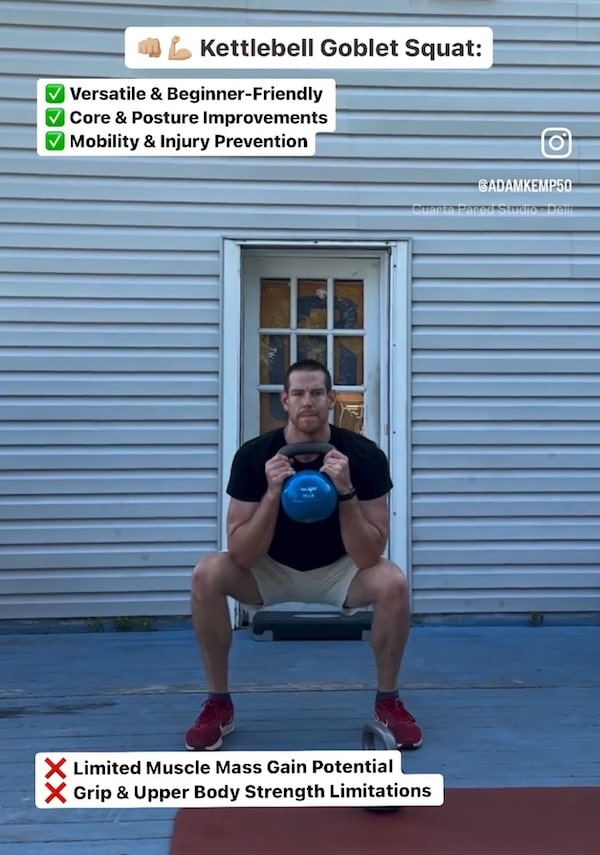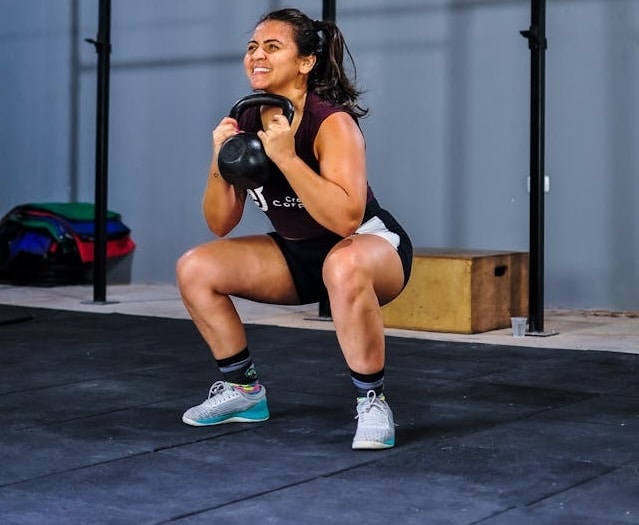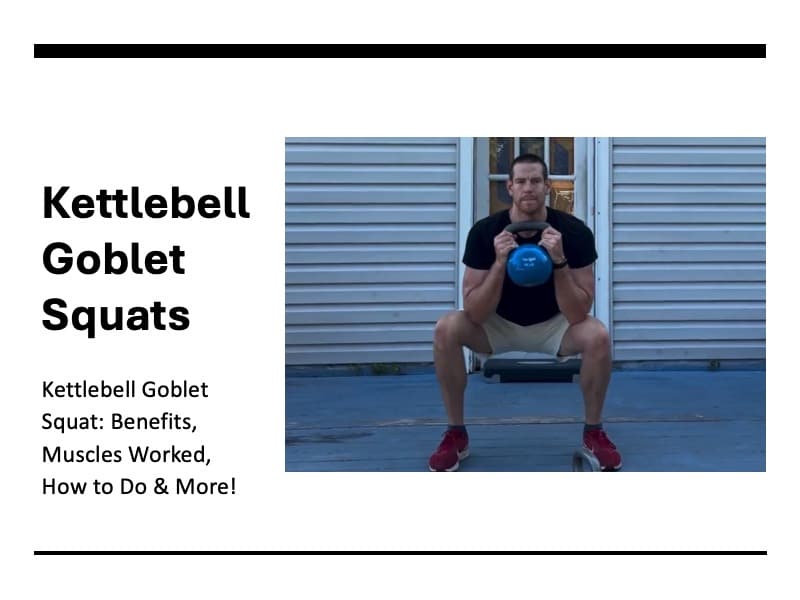Kettlebell Goblet Squat: Benefits, Muscles Worked, How to Do
The kettlebell goblet squat is a powerful, versatile exercise that belongs in nearly everyone’s workout routine.
I first learned about the goblet squat exercise while in college, and both kettlebell and dumbbell goblet squats have been in my workout routine ever since.
I regularly do kettlebell goblet squats not only because they improve my strength but also because they are incredibly beneficial for maintaining the health of my hips, knees, and ankles.
As an added bonus kettlebell goblet squats are great for your grip and upper back strength!
Whether you’re a beginner learning the basics or an advanced lifter refining your technique, this movement offers numerous benefits that extend beyond just building strength.
Read below to learn the benefits, how to properly perform the kettlebell goblet squat, the muscles it targets, and essential safety tips to maximize your results.
What Is the Kettlebell Goblet Squat?
The kettlebell goblet squat is a compound lower-body exercise performed by holding a kettlebell close to your chest in a “goblet” position while squatting.
This front-loaded stance naturally encourages an upright torso, helping you maintain proper form and reduce stress on the lower back.
It effectively strengthens the quadriceps, glutes, hamstrings, and core while also improving balance and coordination.
The exercise promotes greater hip, knee, and ankle mobility, which translates to smoother, more efficient movement patterns in daily life and athletics.
Because of its versatility and accessibility, the kettlebell goblet squat is one of the best exercises for building functional strength and movement quality for all fitness levels.
Benefits of the Kettlebell Goblet Squat

Here is some specific information on the benefits of the kettlebell goblet squat:
Improves Lower Body Strength
The kettlebell goblet squat effectively targets the quadriceps, glutes, and hamstrings.
The combination of depth and control in this movement helps develop balanced strength throughout the lower body, which is essential for activities ranging from sprinting and jumping to climbing stairs and performing daily tasks.
Research has also confirmed the value of kettlebell-based training in improving strength, power, flexibility, and postural control across a wide range of athletic and functional settings.
A 2024 review published in Cureus highlights that kettlebell exercises, like the KB goblet squat, effectively target the hip, thigh, core, and abdominal muscles, improving lower-limb alignment, core activation, and total-body stability while reducing injury risk in athletes (Jaiswal et al., 2024).
These findings reinforce why kettlebell goblet squats are such a powerful addition to any training program focused on performance, longevity, or rehabilitation.
Develops Core Stability & Control
One of the most overlooked aspects of the KB goblet squat is its demand on your core.
Holding the kettlebell in the front-loaded position requires deep abdominal engagement to stabilize the spine and maintain posture.
This makes it one of the best kettlebell ab exercises for both strength and spinal health.
Increases Hip, Knee & Ankle Mobility
Squatting with a kettlebell in front of the chest naturally promotes better movement mechanics, as it encourages greater hip flexion, proper knee tracking, and more ankle mobility.
Over time, this leads to improved joint range of motion, reduced stiffness, and better movement efficiency both in and out of the gym.
Builds Grip Strength
Holding the kettlebell by the horns challenges your grip throughout the entire set. This not only improves forearm and hand strength but also carries over to deadlifts, pull-ups, and everyday tasks like carrying groceries or lifting heavy objects.
It is one of the best ways to increase your grip strength.
Strengthens Upper Back and Shoulders
The kettlebell’s position requires your upper back, scapular stabilizers, and shoulders to remain active, keeping the weight secure.
This strengthens the postural muscles and enhances shoulder joint integrity, which is crucial for individuals who sit for extended periods or deal with rounded shoulders.
Safer for Beginners and Those with Injury History
Compared to barbell back squats, the goblet squat places less compressive force on the spine and allows for a more natural squatting posture.
It’s a great option for people with back pain, knee issues, or mobility limitations, offering a low-risk way to build strength without compromising safety.
Versatile and Accessible
From bodyweight-only beginners to experienced lifters using heavy kettlebells, this movement adapts easily.
You can increase the difficulty by using tempo variations, pauses, or different rep schemes, making it ideal for strength training, hypertrophy, fat loss, or rehabilitation.
Muscles Worked in the Kettlebell Goblet Squat

The kettlebell goblet squat is a highly efficient compound movement that engages multiple major muscle groups in a coordinated and functional way.
This makes it an excellent choice for full-body strength development, especially when training with limited time or equipment.
Below are the primary muscles used in the KB goblet squat:
Quadriceps
The quadriceps femoris, located at the front of the thighs, are the primary drivers during the upward phase of the squat.
These muscles extend the knees and are most engaged when rising out of the bottom position.
Strong quads are essential for explosive power in jumping, sprinting, and general lower-body endurance.
Glutes
The gluteus maximus, medius, and minimus play a central role in hip extension and stabilization during the squat.
As you descend, the glutes help control the movement, and during the ascent, they contract powerfully to drive the hips forward.
Proper glute activation also helps protect the lower back and supports better pelvic alignment.
Hamstrings
Located on the back of your thighs, the hamstrings assist in knee flexion and hip extension throughout the squat.
They help decelerate the downward phase and contribute to a smooth, powerful return to the standing position.
Strengthening the hamstrings balances out the quadriceps and can reduce the risk of hamstring strains or knee injuries.
Core
The kettlebell goblet squat heavily recruits the deep core musculature, including the rectus abdominis, transverse abdominis, and internal and external obliques.
These muscles work isometrically to brace the spine and stabilize the torso throughout the movement.
A strong core not only improves squat mechanics but also helps develop proper posture and increases resilience to injury during other lifts and daily tasks.
Forearms
The forearm flexors are engaged isometrically to maintain a secure grip on the kettlebell throughout the set.
This sustained contraction builds forearm strength and endurance, which in turn translates to improved performance in exercises such as pull-ups, deadlifts, and farmer’s carries.
Grip strength is also a strong predictor of overall health and aging performance.
Upper Back and Shoulders
The muscles of the upper back, particularly the rhomboids, traps, and rear deltoids, are activated to hold the kettlebell close to your chest in a stable front-racked position.
Meanwhile, the shoulders, especially the deltoids and rotator cuff stabilizers, assist in maintaining scapular retraction and upper body posture.
This engagement helps counteract the tendency to round the upper back and promotes thoracic spine control.
How to Do the KB Goblet Squat
Executing the kettlebell goblet squat with proper technique is essential for maximizing results and minimizing the risk of injury.
Whether you’re using it as a warm-up drill, strength builder, or mobility exercise, mastering the fundamentals of this movement will pay off across your entire training program.
Step 1: Set Your Stance
Stand tall with your feet about shoulder-width apart and your toes turned slightly outward.
Grip the kettlebell by the horns (the outer sides of the handle) and hold it close to your sternum with your elbows pointing downward and tucked in.
This position should feel balanced and strong, with your core lightly braced and shoulders down and back.
Tip: Keep your wrists straight and avoid letting the kettlebell pull your hands downward.
Step 2: Initiate the Descent
Begin the movement by pushing your hips back slightly while simultaneously bending at the knees.
Imagine you’re lowering yourself onto a box behind you.
Keep your chest lifted, spine neutral, and eyes looking straight ahead as you descend.
Tip: This phase should be slow and controlled to maintain tension through your legs and core.
Step 3: Find Your Depth
Lower your body until your thighs are at least parallel to the floor, or as deep as your mobility allows without rounding your back or collapsing your knees inward.
Make sure that your knees track in line with your toes and that your heels stay grounded throughout the movement.
Tip: If your mobility limits your depth, work within your range and gradually improve it over time.
Step 4: Drive Up With Control
Push through your heels and engage your glutes and quads to return to the starting position.
As you rise, focus on keeping your torso upright, core tight, and kettlebell secure at chest level.
Tip: Fully extend the hips at the top without leaning back or overextending your spine.
Step 5: Repeat With Precision
Perform the desired number of repetitions, ensuring every squat maintains strict form. Quality reps are far more effective than simply rushing through a set.
Tip: You can increase difficulty by slowing your tempo, adding a pause at the bottom, or progressing to heavier kettlebells as your strength improves.
Safety Tips for the Kettlebell GOblet Squat
Proper form and smart progressions are essential for preventing injuries and maximizing the effectiveness of kettlebell goblet squats.
Whether you’re brand new to strength training or using this movement as a joint-friendly alternative to barbell squats, following these safety tips will help you train smarter and safer:
Start Light and Focus on Form
Choose a lighter kettlebell when learning the movement so you can dial in your technique without overloading your joints.
Building a strong movement pattern early helps prevent poor habits and sets the foundation for safe strength gains.
Once your form feels consistent and controlled, gradually increase the weight based on your strength and mobility.
Keep a Neutral Spine and Upright Posture
Maintain a tall, upright torso with your chest lifted and shoulders back throughout the squat.
Avoid rounding your lower back or leaning too far forward, which can place excessive stress on the lumbar spine.
Bracing your core and keeping the kettlebell close to your chest will help you stay in a safe position throughout the lift.
Control the Tempo, Especially on the Way Down
Move slowly and intentionally through each repetition, especially during the lowering phase.
Rushing into the bottom position can lead to joint strain and diminished muscle engagement.
Using a controlled descent increases muscle activation and improves proprioception (body awareness).
Monitor Knee Alignment
Ensure that your knees stay in line with your toes and don’t collapse inward during the descent or ascent.
Poor knee tracking increases the risk of ligament strain and patellar discomfort.
If needed, slightly adjust your stance width or foot angle to accommodate natural joint structure and mobility.
Bonus: Choose the Right Footwear
Choosing the best workout shoes for each of your workouts can play a significant role in helping you maintain your health.
For KB goblet squats, opt for shoes with flat, firm soles that allow for full foot contact with the floor.
Avoid running shoes or highly cushioned footwear that can throw off your balance and reduce power transfer.
If you’re squatting at home, minimalist training shoes or barefoot training are often better for ground connection and stability.
Final Thoughts: Is the Kettlebell Goblet Squat a Good Exercise?

The kettlebell goblet squat is one of the most effective and accessible functional exercises for building strength, improving mobility, and reinforcing proper squat mechanics.
Whether you’re new to training or an experienced athlete, this movement can help you improve lower body power, core stability, and postural control without placing excessive stress on your joints.
It’s not just a beginner-friendly alternative, it’s a foundational tool that scales with your progress and delivers real results.
By incorporating kettlebell goblet squats into your routine with proper form and intention, you’ll support long-term performance, injury prevention, and overall body strength.
Frequently Asked Questions About the Kettlebell Goblet Squat
Read Next: How Many Squats Should You Do Per Day?
This website does not provide medical advice. This website site does contain affiliate links, and purchases may earn a commission.
Read my Medical Disclaimer, Review Disclaimer, and Publishing Policies for more details. Use of this site indicates acceptance of these terms.



